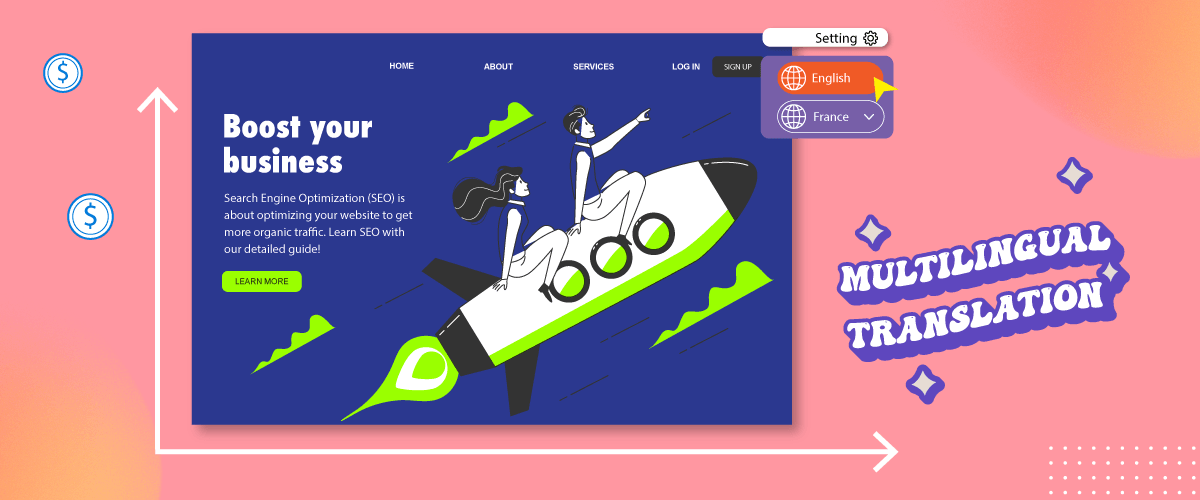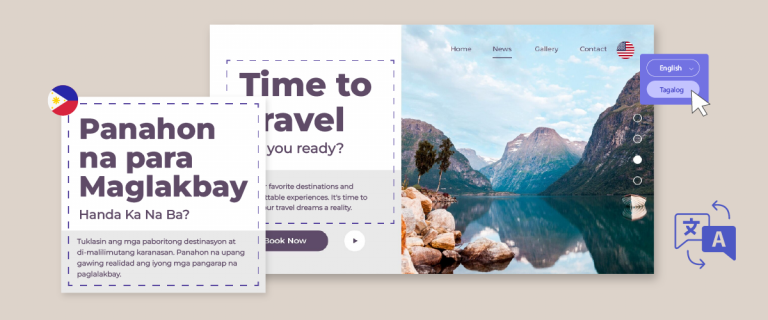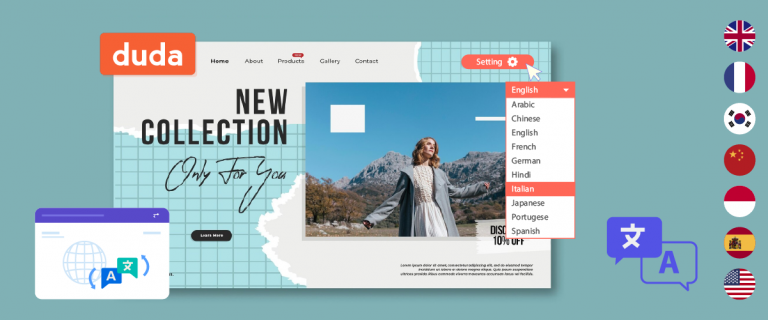Do you have a blog website and want to increase site traffic? Multilingual translation can help boost site traffic.
According to data from Bright Plugins, 75% of internet users need to speak English as their primary language. While English may be the main language of your blog, with multilingual translation, you can reach 75% of new visitors beyond English speakers. This will undoubtedly help increase blog traffic.
To better understand the steps that can be taken to increase your blog traffic with multilingual translation, keep reading this article till the end!
Benefits of increasing traffic to the website
Before discussing tips to increase your blog traffic. First, we will discuss the benefits of increasing website traffic.
- More potential customers – Higher traffic exposes your business to more people who could become customers. The more people visit your site, the greater the chances of converting them. With a wider audience reach, you gain more opportunities to showcase your products/services to potential new customers. Target relevant content and promotions to attract potential customers visiting your site.
- Increased brand awareness – The more people visit your website, the more they become aware of your brand, products, or services. This increased exposure is critical for building brand recognition. When people are familiar with your brand, they’re more likely to trust it, recommend it to others, and return to it in the future. Brand awareness often leads to brand loyalty, which is invaluable for long-term business success.
- Better search engine rankings – Most search engines factor traffic into rankings. More organic traffic to your site from search can improve your SEO rankings. By attracting more visitors directly through search engines, you can build authority signals that indicate to search engines that your content is valuable, trustworthy and deserves a higher ranking. Content that is visited more often tends to get better rankings on SERP.
- More data and feedback – Higher traffic provides more user data and feedback that you can analyze to improve your products, content, and user experience. With more people visiting your site, you gain valuable insights into visitor behavior, needs, pain points, and preferences enabling you to refine your offerings. User data is critical for future business development.
- Increased credibility – A popular website with high traffic gives the impression that your business is thriving and established. This boosts trust and credibility. People today often judge how credible a business is by how professional their website looks and how much traffic it attracts. A high-traffic site builds a perception of success. High traffic makes potential customers confident to purchase from and do business with you.
How to increase your blog traffic with multilingual translation
After knowing the various language translation methods you can choose, let’s discuss the steps to increase blog traffic using language translation.
Understanding target audience & keyword
To increase blog traffic through multilingual translation, the first step is understanding the target audience for each language or country. You can start researching and analysing the target audience’s demographics, behaviour, content preferences, and popular topics.
Find out the latest developments in each relevant target country related to your blog’s topic. Also, identify keywords and phrases frequently searched by the audience in their respective languages. This information will help determine the type of content that should be translated.
By understanding the target audience in each language or country, you can create relevant translated content, increasing the chances of capturing the interest of foreign readers.
Target keywords can be identified using various keyword research tools, such as.
- Ahrefs
- Semrush
- Ubersuggest
- Google Keyword Planner, etc.
Choose the right method translation
To produce multilingual translations, a blog website translation method is needed. In general, there are three types of methods that web owners usually use, you can choose which is the best from the following third method.
- With browser translation: auto-translation feature available in some web browsers like Google Chrome, Mozilla, etc. This feature allows website visitors to translate web page content into the language of their choice with just one click. Even though it is easy, the quality of browser translation is often not good and does not pay attention to grammar and cultural nuances. And most importantly, it doesn’t support SEO optimization.
- Human translation: translation of blog content by professional translators or native speakers of the target language. The quality of the translation is much better because it pays attention to context, language style and nuances. However, the disadvantage of human translation is that it takes more time. Then, the costs required to hire a professional translator are quite expensive. This is unsuitable for websites that are still starting or small in scale.
- Machine translation: uses AI and machine learning technology to automatically translate content. The costs are relatively lower, and the translation process can be done quickly. Several translation services already provide translation editing features to improve results and collaboration features with translators and support SEO optimization. Therefore, machine translation is the right solution, you can perform language translation automatically and collaborate with human translation.
Translate all blog element
Consistent language translation must be applied to all elements of the blog website, not just its article content. Some aspects that also need to be translated include.
- Widgets
- Navigation menu
- Categories
- Tags
- Meta descriptions
- Alt text and other elements.
Consistent translation across all blog elements provides convenience for readers. Foreign readers would want to navigate the blog easily without encountering a mix of languages. Ensure that the blog’s menu and navigation are translated so they can find relevant content.
If your blog is an eCommerce website, translate checkout and cart pages. These pages are crucial for the continuity of sales conversions.
Translating all blog elements may require extra effort but will impact the visitor experience. They will be more comfortable accessing your blog, leading to higher traffic.
Use best technology / tools
Translating blog content into various languages requires the use of technology or tools that can help the translation process be faster and provide accurate results.
One management system that can be used is a translation plugin. There are two types of translation plugins, namely those that can translate manually and automatically.
Automatic translation plugins are often the first choice because they can translate content automatically without having to input the translation results first.
There are various types of the best translation plugins, for example Linguise which offers support for content detection, fast translation, a built-in dashboard with various features such as sending translations, a live editor, and statistics on translated pages visited.
These features can help you be more effective in translating blog content.
Localized your blog content
When translating blog content, don’t just translate word-for-word; adjust to being locally relevant for each target country or language audience.
Content adaptation is crucial to enhance cultural relevance. Some ways to localize content include.
- Adapting formats such as date, currency, and others.
- Adjusting text or language style according to the country.
- Adapting writing formats like right-to-left languages. This writing format is typically used in Arabic, Persian, Hebrew, etc.
- Pay attention to cultural norms and local customs so as not to cause misunderstandings.
Blog content should be created as if written explicitly for readers in the target country. This will further enhance the emotional connection with visitors.
Proper website localization will make your blog more easily understood by readers from various countries.
Implementing SEO multilingual
One thing that can boost blog traffic is having your site content appear on Google’s first page. This can be achieved by consistently applying multilingual SEO.
Here are some tips for implementing multilingual SEO to increase blog traffic through multilingual content.
- Target keywords: Identify popular phrases and keywords native speakers use in each language/country to search for related topics. Optimize the use of these keywords.
- URL/subdomain structure: Use a specific domain or subfolder with language/country codes so that search engines know which version of the content is relevant.
- Submit multilingual sitemap: Submit a multilingual sitemap to ensure that crawlers index all your blog content.
- Hreflang tags: an HTML code that provides signals to search engines about the language of a web page and the targeted geographical region. Hreflang codes help search engines determine which language and country your content should be displayed.
- Optimize on-page content: Optimize your content, including titles, headings, meta descriptions, and keyword distribution.
The better the SEO optimization for each piece of content, the higher the chance your blog content has to appear on the first page of Google. Consequently, visitors will find your content more easily and access your blog.
Ensuring consistent quality across languages
The next tip is to maintain consistent quality of translation of blog content in various languages. Translation consistency in each language will ensure correct and consistent use of terms in all content translations.
Before publication, content translations should be checked first by native speakers or translators of the target language to ensure the quality and accuracy of the translation.
This consistency also needs to be applied to brand names or technical terms. Usually special phrases like this are left in the original language. To do that, you can use the service’s exclude translation feature on the translations you use.
With these steps, you can maintain high quality standards and consistent translation of blog content across different target languages. This is important to provide the same good reader experience in all language versions provided.
Promote your multilingual blog content
The final tip is to promote your multilingual translated blog content, especially on social media. This is because, according to Bright Plugins, multilingual content has a sharing rate that is twice as high on social media, thereby aiding in increasing site traffic.
Firstly, optimize search engines by implementing effective multilingual SEO for each language version of your content. This makes the content easily discoverable through local searches.
Engage in promotion across all social media platforms associated with your company or website. You can also collaborate with influencers and communities within the same niche to help disseminate their language-specific content.
With the correct language translation promotion, this will help redirect traffic to the site, increasing overall traffic.
Monitoring and analytics performance
After translating blog content, monitor and analyze its performance. Use web analytics tools like Google Analytics to track traffic, engagement metrics, and conversions for each translated language version.
From this data, identify which blog content in a particular language has high and low performance. Content with high traffic means the translation is successful in attracting readers. While content with a low response may require improving translation quality.
With close monitoring and analysis, you can continuously optimize your multilingual content strategy for the best results. Global reader traffic and interest will continue to increase.
Keep up-to-date with content
It is important to keep the content updated. Ensure all language versions are always in sync and contain the latest information. Not only in the language but also in trends and popular topics in each destination country.
So you can produce translated content relevant to readers’ current interests. Conduct regular keyword research for each language to ensure content matches searches.
Keeping multilingual content up to date is important for providing a consistent reader experience and relevant information across all language versions.
Translate your multilingual blog to increase traffic with Linguise
Translation of the content on a blog can be done with the help of machine translation, as explained above. Currently, there are various automatic translation services available on the internet.
Choose a translation service from the various services available with the most comprehensive features that suit your needs. One of the automatic website translation services is Linguise. Linguise is integrated with more than 40 CMS and is compatible with various websites, such as blogs.
Some other features that can assist in creating a multilingual blog include a live editor feature used to edit translations directly and the exclude translation feature that you can use if there are specific terms or phrases on the blog that you do not want to be translated.
And most importantly, Linguise supports 100% SEO optimization. This means that your blog remains well-optimised even when translated into various languages, including the automatic application of hreflang, canonical, multilingual sitemap, and many more.
Finally, you can also add and setup access for translator feature, where you can add as many translators as needed and collaborate with them.
With these various features, your blog will be translated into many languages, potentially increasing blog traffic.
Conclusion
By now, you already know the steps to increase your blog traffic with multilingual translation. Additionally, you are aware of the benefits that come with increased blog traffic.
So, it’s now your turn to implement these steps on your respective blogs. Remember to use automatic translation services with the best quality translation results.
Linguise offers a one-month free trial for those interested in trying it out. Therefore, let’s register a Linguise account and then follow the guide on how to add website domain for translation.




